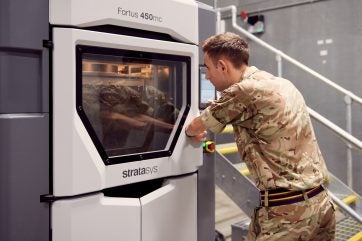
GlobalData forecasts a paradigm shift in aerospace and defence logistics as 3D printing technology emerges as a solution, enabling on-demand production of mission-critical components and addressing longstanding challenges in spare parts accessibility and standardisation.
The burgeoning 3D printing market is poised to reshape the landscape of aerospace and defence industries, transcending conventional manufacturing norms and ushering in a new era of logistical efficiency and operational agility. According to GlobalData, a leading data and analytics company, the trajectory of the 3D printing industry signals transformative implications, with projections exceeding $70bn by 2030.
Contrary to traditional manufacturing methods, 3D printing, also known as additive manufacturing, offers flexibility and responsiveness, particularly in addressing the needs of the aerospace and defence sectors.
Wilson Jones, a defence analyst at GlobalData, underscores the role of 3D printing in augmenting military capabilities, citing instances such as the ongoing conflict in Ukraine, where combat deployment of 3D printers has been observed to fabricate mission-critical components for the Ukrainian armed forces.
Moreover, the advent of 3D printing technology heralds a shift in logistical paradigms, with the ability to produce components on-site, negating the need for inventories and circumventing logistical bottlenecks. As exemplified by initiatives such as the US Army Research Laboratory’s project to enable in-field unmanned aerial vehicles (UAVs) manufacturing, 3D printing facilitates real-time equipment production, enhancing operational readiness and reducing dependency on traditional supply chains.
The integration of 3D printing technology is already happening in the US naval industry. HII, a player in naval manufacturing, has harnessed additive manufacturing to enhance efficiency and flexibility in producing components for vessels like the John F. Kennedy (CVN 79) aircraft carrier.

US Tariffs are shifting - will you react or anticipate?
Don’t let policy changes catch you off guard. Stay proactive with real-time data and expert analysis.
By GlobalDataFurthermore, HII’s collaboration with General Dynamics Electric Boat (GDEB) and 3D printing companies like AMMCON has yielded submarine solutions, such as using 3D printed copper-nickel parts for the Virginia-class submarine fleet. This transition to additive manufacturing accelerates the shipbuilding process and addresses shortages and maintenance delays plaguing the US Navy’s submarine programmes.
Jones emphasises the potential of 3D printing across various facets of military operations, from the production of specialised vehicle components to the fabrication of imperial-sized tools necessitated by unit measurement disparities. The versatility and cost-effectiveness of 3D printing technology offer a solution to longstanding challenges, enabling rapid adaptation to evolving operational requirements and mitigating logistical complexities.
As the 3D printing market continues its growth trajectory, its integration into the aerospace and defence sectors promises to change logistics, bolster operational resilience, and empower military forces with agility and adaptability in the face of evolving threats and challenges.



